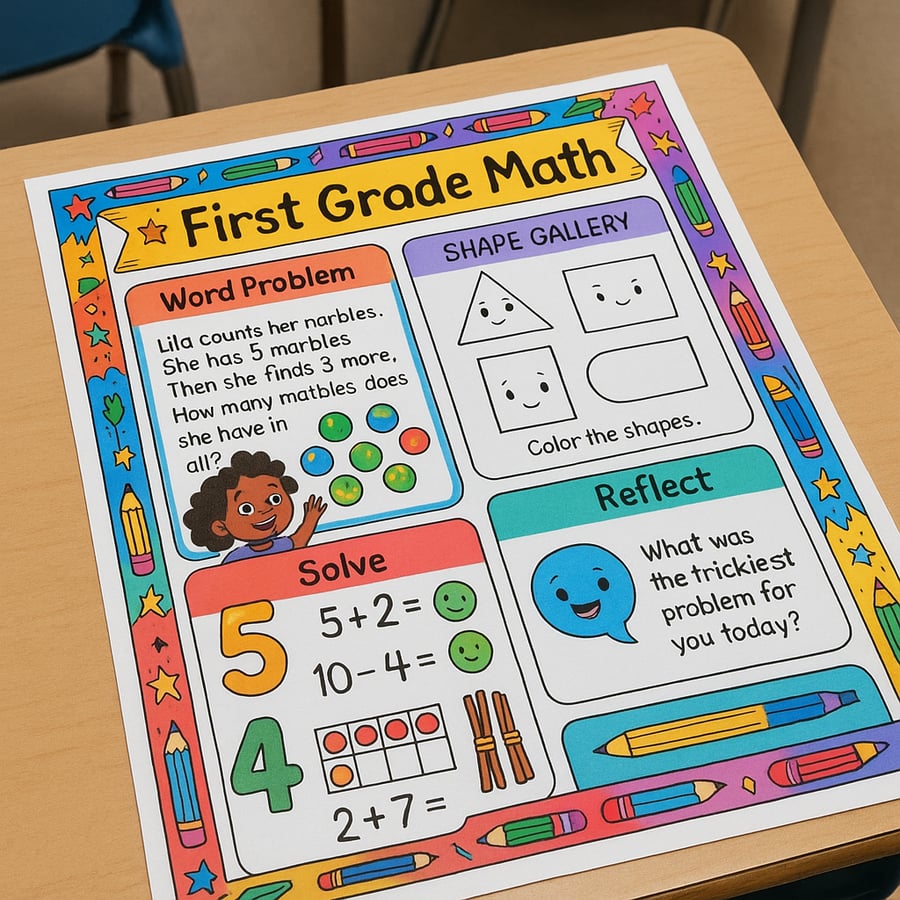How to Create a Third Grade Math Worksheet That Connects Skills to Meaning
How to Create a Third Grade Math Worksheet That Connects Skills to Meaning
Many teachers look for ready-made third-grade math worksheets, but the most effective tools can be the ones you create yourself—tailored to your students’ needs and anchored in your classroom’s story of learning.
If you are interested in participating in a fellowship through MathTrack Institute about these topics, you can learn more here:
Third grade is a landmark year in mathematics. Students move from building foundations to mastering concepts that will carry into upper elementary and beyond. Multiplication and division take center stage, fractions make their first major appearance, and problem-solving becomes more complex.
A worksheet at this stage should do more than review skills—it should help students see the connections between ideas, understand the “why” behind the “how,” and recognize themselves as capable problem-solvers.
Below, we’ll highlight the core third-grade standards and offer ways to design worksheets that build both skill and meaning.
1. Multiplication and Division Within 100 — Expanding the Cast of Characters
Standards Connection: Fluently multiply and divide within 100, using strategies such as the relationship between multiplication and division.
Worksheet Idea:
- Mixed multiplication and division problems to strengthen fact families.
- Array and area model problems to visualize the operations.
- Word problems that require choosing between multiplication and division.
Storytelling Lens: We think of teachers as storytellers. Through this role, multiplication and division are no longer guests—they’re leading characters. Students learn how these operations interact, sometimes working together, sometimes undoing each other’s work. A worksheet can frame them as partners in solving problems, each with its own way of moving the story forward.
2. Fractions as Numbers — Introducing a Complex New Character
Standards Connection: Understand a fraction as a number on the number line; represent fractions and compare them.
Worksheet Idea:
- Place fractions on a number line.
- Shade models to show unit fractions and non-unit fractions.
- Compare fractions with the same numerator or denominator.
Storytelling Lens: We think of teachers as storytellers. Through this role, fractions enter as mysterious but important new characters—parts of a whole that have their own place in the number world. The worksheet can help students “meet” these characters through visuals and comparisons, making them less intimidating and more familiar.
3. Area and Perimeter — Giving the Story New Settings
Standards Connection: Understand concepts of area and relate it to multiplication and addition; solve real-world problems involving area and perimeter.
Worksheet Idea:
- Find the area of rectangles by counting squares and using multiplication.
- Perimeter word problems using grids or diagrams.
- Compare figures with the same area but different perimeters.
Storytelling Lens: We think of teachers as storytellers. Through this role, area and perimeter are like two sides of the same coin—they describe the “space inside” and the “path around” in every shape’s story. Worksheets can let students explore how these concepts play together, showing that math describes both the inside and the outside of a figure’s world.
4. Understanding and Interpreting Data — Mapping the Plot
Standards Connection: Draw scaled picture graphs and bar graphs; solve problems using information from the graphs.
Worksheet Idea:
- Create bar graphs from given data.
- Answer comparison questions (“How many more?” / “How many fewer?”).
- Use graph data to solve two-step problems.
Storytelling Lens: We think of teachers as storytellers. Through this role, graphs are maps of the plot—they show where the action is, where change is happening, and how characters (data points) relate. Worksheets can invite students to be detectives, interpreting what the data’s “story” tells them.
5. Geometry — Meeting New Shapes and Angles
Standards Connection: Recognize and draw shapes with specified attributes; understand that shapes in different categories may share attributes.
Worksheet Idea:
- Classify shapes based on attributes.
- Draw shapes with given angles or side lengths.
- Identify shared attributes across categories.
Storytelling Lens: We think of teachers as storytellers. Through this role, Geometry in third grade introduces students to the idea that characters (shapes) can belong to multiple “families.” A worksheet can help students see how these relationships connect, much like discovering a character’s backstory.
6. Reflection — Stepping Back from the Action
To build metacognition into every worksheet, include a small reflection box with prompts like:
- “What new strategy did you use today?”
- “Which problem made you stop and think?”
- “How could you explain one problem to a younger student?”
These reflections keep students in the role of co-author rather than just audience.
This mirrors the Reflect stage from the BEAR worksheet—encouraging students to see themselves as co-authors of their learning story. You can download an example of that here:
Final Thoughts
A third-grade math worksheet should feel like a turning point in the story—where familiar characters are more skilled, new characters add intrigue, and connections deepen. By designing worksheets with story, you help students not only practice skills but also see the bigger picture, preparing them for the chapters ahead.
When students see math as an unfolding narrative, they are more likely to stay curious, engaged, and ready for the next challenge.


